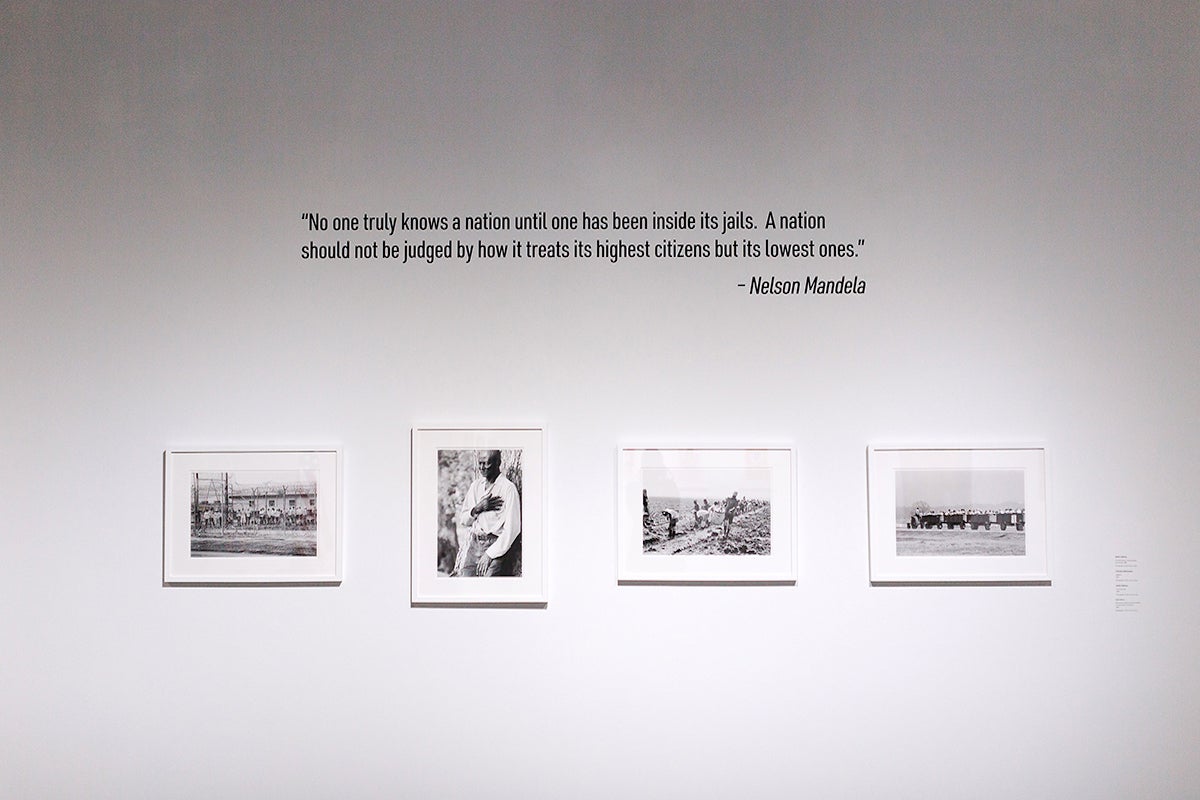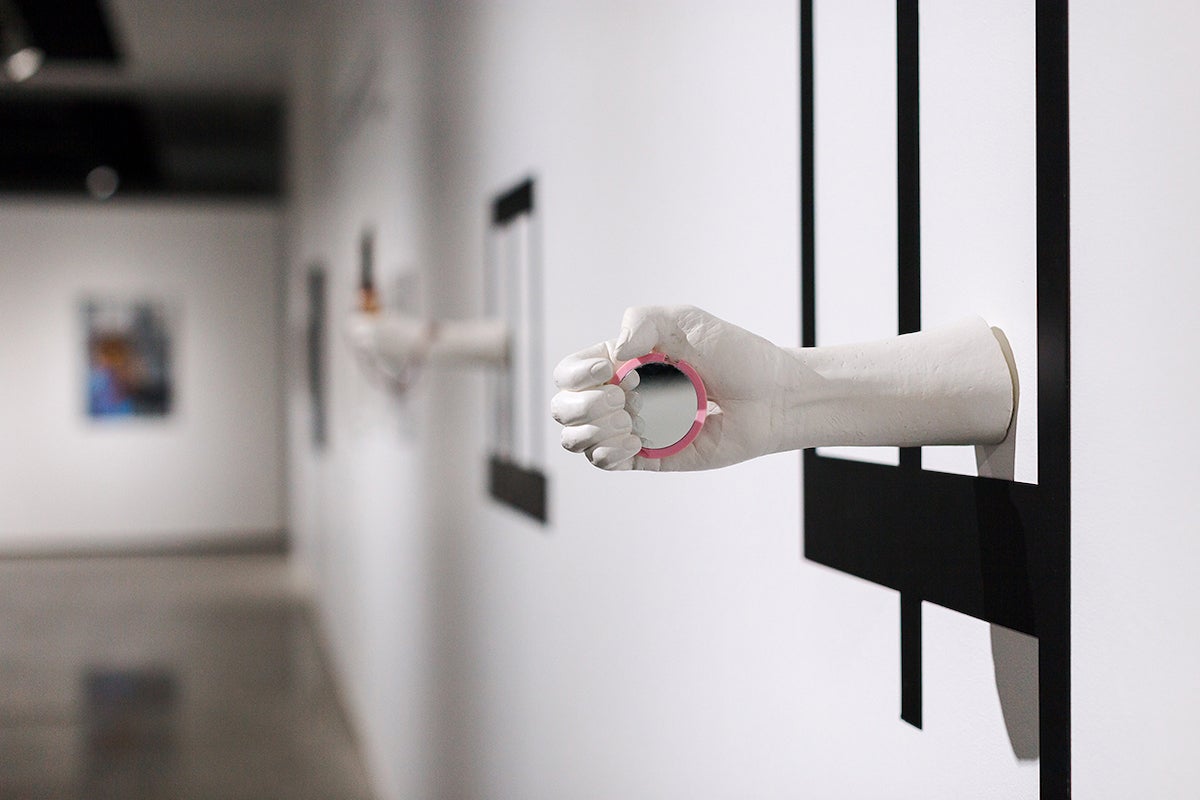Although there are more than 2.3 million people incarcerated in the United States, UCF associate professor Keri Watson believes the prison system remains largely invisible to the majority of Americans. She intends to change that with the first UCF Art Gallery exhibition of the 2020-21 academic year, Illuminating the Darkness: Our Carceral Landscape.
The exhibition, which is available online indefinitely and in person on campus through Oct. 1, shines a light on the effects of mass incarceration on the lives of Americans. The exhibition is a culmination of a two-year project that brought contemporary artists to Central Florida to participate in a series of discussions with inmates enrolled in classes as part of the Florida Prison Education Project.
Watson is the exhibit’s curator as well as an associate professor of art history in the School of Visual Arts and Design and founding director of the Florida Prison Education Project. She shares her thoughts about the importance of the exhibit.
What inspired you to curate this exhibition that explores mass incarceration?
Mass incarceration is among the most crucial issues of our time. Although the United States comprises only 5% of the world’s population, we house more than 25% of its prisoners, and since 1978, the U.S. prison population has increased 408%. Today, 2.3 million Americans are incarcerated and Florida has America’s third largest prison system, with nearly 100,000 people behind bars. This exhibition is sponsored by the Florida Prison Education Project, a UCF Community Challenge Initiative that brings higher-education opportunities to people incarcerated in Central Florida and seeks to integrate social justice into the UCF curriculum. FPEP received a National Endowment for the Arts Artworks grant to bring contemporary artists whose work engages with systemic racism and mass incarceration to Central Florida to offer guest lectures in classes offered by UCF at an area prison and to contribute work to this exhibit.
What is the significance of hosting Illuminating the Darkness: Our Carceral Landscape now?
“This exhibition seeks to draw attention to systemic racism, to demonstrate to people the ways in which we are all complicit in racism and mass incarceration, and to offer opportunities for people to get involved in the conversation and the movement toward creating a just and equitable society.” — Keri Watson, UCF associate professor
Slavery, Jim Crow and redlining institutionalized economic, educational and social disadvantages that dispossessed African Americans of wealth and property. One in three Black men can expect to serve time in prison as opposed to one in 17 white men, and nearly 40 of people in prison are Black. Incarceration amplifies psychological, social and cultural divides — increasing the distance between white and Black, rich and poor, abled and disabled.
As protestors come together to mourn the murders of George Floyd, Eric Garner, Breonna Taylor, Michael Brown, Tamir Rice, Justin Howell, Sean Monterrosa, Jamel Floyd and so many others, the dependence of our nation on oppression and white supremacy continues to reveal itself to many who have looked away for too long, making this conversation even more timely. According to a recent study by the National Academy of Sciences, police violence is a leading cause of death for young men in the U.S. with black men 2½ times more likely to be killed by police than white men.
The median annual income of people prior to their incarceration is $19,185, and according to a 2020 Prison Policy study, 1 in 5 incarcerated people is locked up for a nonviolent drug offense. Incarceration also has detrimental physical and psychological effects on those imprisoned, and one in five people in prison has a serious mental illness.
This exhibition seeks to draw attention to systemic racism, to demonstrate to people the ways in which we are all complicit in racism and mass incarceration, and to offer opportunities for people to get involved in the conversation and the movement toward creating a just and equitable society.

How did you select the artists you included in the exhibition?
Illuminating the Darkness: Our Carceral Landscape presents the work of 25 artists whose practice is informed by their experiences with the criminal justice system. Many of the artists are either incarcerated or formerly incarcerated and their work, in sculpture and installation, drawing and painting, video and photography, and printmaking and book arts explores racism, oppression and the immutability of the human spirit. Featured artists include Al Black, Omari Booker, Courtney Bowles, Keith Calhoun, Daniel McCarthy Clifford, Baz Dreisinger, Christopher Etienne, Jason Fronczek, Maria Gaspar, Shaun Leonardo, Chandra McCormick, Jhafis Quintero, Paul Rucker, Charles Smith, Mark Strandquist, Hank Willis Thomas, Matt Watson, Purvis Young, and FPEP student participants who are currently incarcerated. These artists were selected because of their personal experiences with the criminal justice system and for their commitment to social justice.
“As a formerly incarcerated artist, I have reaped the emotional, spiritual and therapeutic benefits of creating art while incarcerated and also participating in higher education while incarcerated. As we seek a more humane path to justice we must find ways to value and support people who are incarcerated.” – Omari Booker says of Illuminating the Darkness: Our Carceral Landscape
Why did you decide to host Illuminating the Darkness: Our Carceral Landscape at the UCF Art Gallery and why is it important for our students?
According to the Equal Justice Initiative, half of all Americans have family members who have been incarcerated. Many more people are impacted than one may first believe, so we need to have these conversations in order to remove the stigma of incarceration, in order to shine a light on the ways in which we all live in the carceral landscape. Furthermore, colleges and universities — like prisons — are institutions of power and we have to face the structural inequities inculcated in these spaces in order to change them.
This exhibition is on view in-person at the UCF Art Gallery through Oct. 1 and online indefinitely. Admission is free. Visit the website to learn more information about this exhibition as well as new policies to know before you go.




